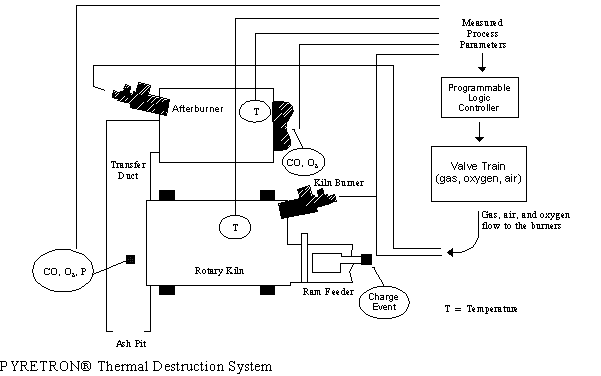
(PYRETRON® Thermal Destruction)
The PYRETRON® thermal destruction technology controls the heat input during incineration by controlling excess oxygen available to oxidize hazardous waste (see figure below). The PYRETRON® combustor relies on a new technique for mixing auxiliary oxygen, air, and fuel to (1) provide the flame envelope with enhanced stability, luminosity, and flame core temperature, and (2) increase the rate of heat released.

The technology is computer-controlled to automatically adjust the temperatures of the primary and secondary combustion chambers and the amount of excess oxygen. The system adjusts the amount of excess oxygen in response to sudden changes in contaminant volatilization rates in the waste.
The technology fits any conventional incineration unit and can burn liquids, solids, and sludges. Solids and sludges can also be coincinerated when the burner is used with a rotary kiln or similar equipment.
The PYRETRON® technology treats high- and low-British thermal unit solid wastes contaminated with rapidly volatilized hazardous organics. In general, the technology treats any waste that can be incinerated. It is not suitable for processing Resource Conservation and Recovery Act heavy metal wastes or inorganic wastes.
The PYRETRON® technology was demonstrated at EPA's Incineration Research Facility in Jefferson, Arkansas, using a mixture of 40 percent contaminated soil from the Stringfellow Acid Pit Superfund site in Glen Avon, California and 60 percent decanter tank tar sludge (K087) from coking operations. The demonstration began in November 1987 and was completed at the end of January 1988.
Both the Technology Evaluation Report (EPA/540/5-89/008) and Applications Analysis Report (EPA/540/A5-89/008) are available from EPA.
The polynuclear aromatic hydrocarbons naphthalene, acenaphthylene, fluorene,
phenanthrene, anthracene, and fluoranthene were selected as the principal
organic hazardous constituents (POHC) for the demonstration. The
PYRETRON® technology achieved greater than 99.99 percent
destruction and removal efficiencies for all six POHCs in all test runs.
Other results are listed below:
EPA PROJECT MANAGER:
Laurel Staley
U.S. EPA
National Risk Management Research Laboratory
26 West Martin Luther King Drive
Cincinnati, OH 45268
513-569-7863
Fax: 513-569-7105
TECHNOLOGY DEVELOPER CONTACT:
Gregory Gitman
American Combustion, Inc.
4476 Park Drive
Norcross, GA 30093
770-564-4180
Fax: 770-564-4192